Reference: AASM (2007). The AASM Manual for the Scoring of Sleep and Associated Events: Rules, Terminology and Technical Specifications. (Westchester: American Academy of Sleep Medicine).
绿色部分来自:http://wenku.baidu.com/link?url=7DQzUI9iM74iN10GrWGvA2iWCtcliFq8zsvPoVGJ4dB16PO2JtmwYEcJUOouL6R71C3A6a7quLESI1VHsiYlzQrql0zPkL1l82qCk9wFC_W
♥ Basic knowledge
1. Stage of Sleep
- W: Wakefulness
- N1: NREM 1
- N2: NREM 2
- N3: NREM 3
- R: REM
where: NREM - Non-Rapid Eye Movement, REM - Rapid Eye Movement.
2. Scoring by Epochs
- Score sleep stages in 30 second sequential epochs commencing at the start of the study;
- Assign a stage to each epoch;
- If 2 or more stages coexist during a single epoch, assign the stae comprising the greatest portion of the epoch.
♥ Stage W
1. 定义
- α波:闭眼状态下一系列枕叶(occipital lobe)部分8-13Hz正弦波,当眼睛睁开时减弱;
- 眨眼:睁眼或闭眼的清醒状态下,频率为0.5-2Hz的成对垂直眼动(conugate vertical eye movement);
- 阅读眼动信息:被试阅读时,出现一系列由一个慢相位紧接着一个反方向快相位组成的成对眼部活动;
- 快速眼动(REM):成对的、不规律的、尖峰的眼部活动,其起始偏差通常持续500ms以下。由于快速眼动通常也是R睡眠阶段的特征,它们也可以在被试清醒状态下环顾四周的情况下见到。
2. 判定规则
- More than 50% of the epoch has aloha rhythm over the occipital region;
- If any of the following are present without visually discernable α rhythm:
A. Eye blinks at a frequency of 0.5-2 Hz;
B. Reading eye movements;
C. Irregular conjugate rapid eye movements associated with normal or high chin muscle tone.
- 枕区α节律占记录帧50%以上判读为W期;
- α节律没有出现在记录帧,但存在下列特征之一者,判读为W期:
A. 频率在0.5 – 2Hz的眨眼动作;
B. 阅读眼动;
C. 不规则的共轭快速眼动伴正常或增强的颏肌电。
3. 注意
- W阶段出现在唤醒状态(包括从完全清醒到困倦的早期阶段)。困倦的电生理和精神生理标志可能出现在W阶段,并一直持续到N1阶段;
- 在W阶段,闭眼状态下,大部分闭眼被试呈现α波。睁眼状态下,EEG由低幅活动活动组成(主要为β频率和α频率),而没有alpha波节律性。大约10%闭眼被试不表现任何α波,另外10%只表现出有限的α波。在这些被试中,枕叶(occipital)EEG活动在睁眼和闭眼的时候呈现相似规律;
- 清醒状态下,眼电图(electro-Oculogram, EOG)可能呈现大概0.5-2Hz的眨眼频率。困意增长时,眨眼频率降低,并且眨眼可能会被缓慢眼动代替(甚至是在连续α波存在的情况下)。在睁眼情况下,可能见到自发眼动或阅读眼动。
- 在W阶段,下巴肌电图(electromyography,EMG)的波幅变化很大,但通常高于睡眠阶段。
♥ Stage N1
1. 定义
- 慢眼动(slow eye movement,SEM):成对、较规则的(reasonably regular)、正弦状眼动,起始偏差通常持续500ms以下;
- 低振幅,多种频率活动:低振幅,主要为4-7Hz活动;
- 顶尖波(vertex sharp waves,V waves):中心区域出现的锋利轮廓的波形,最多持续0.5秒,显著区别于背景活动;
- 睡眠起始:是除了W阶段以外的任何阶段的第一个时段(epoch)。(对大多数被试来说,这通常是N1阶段的第一个时段)。
2. 判定规则
- In subjects who generate α rhythm, score stage N1 if α rhythm is attenuated and replaced by low amplitude, mixed frequency activity for more than 50% of the epoch;
- In subjects who do not generate α rhythm, score stage N1 commencing with the earliest of any of the following phenomena:
A. Activity in range of 4-7 Hz with slowing of background frequencies by ≥1 Hz from those of stage W;
B. Vertex sharp waves;
C. Slow eye movements.
- 有α节律者,如α节律减弱并被低波幅混合频率活动取代,且后者占一帧的50%以上,判读为N1期;
- 无α节律者,呈现下列现象之一时,判读为N1期:
A. 较W期脑电背景频率减慢≥1Hz的4-7Hz脑电波;
B. 顶尖波;
C. 缓慢眼动。
3. 注意
- 顶尖波可能会在N1阶段出现,但不是判定N1阶段的必要条件;
- 眼电图常常在N1阶段中显示慢眼动,但不是判定N1阶段的必要条件;
- N1阶段中,下巴肌电图振幅多变,但通常低于W阶段;
- 尽管慢眼动通常会在α波开始减弱前开始,但对于那些不产生α波的被试来说,睡眠潜伏期通常会比产生α波的被试稍微短一点。
♥ Stage N2
1. 定义
- K复合波(K complex):去线性负尖波,紧跟着一个显著区别于背景EEG的正性成分,总共持续超过0.5秒,通常在使用frontal derivations(?)记录的时候振幅达到最大。一个和K复合波相关的唤起必须在K复合波结束之后的一秒内开始。
- 睡眠纺锤波(sleep spindle):一系列频率在11-16Hz(12-14Hz内最常见)的独特波形,持续超过0.5s,通常使用central derivations时振幅最大(usually maximal in amplitude using central derivations)。
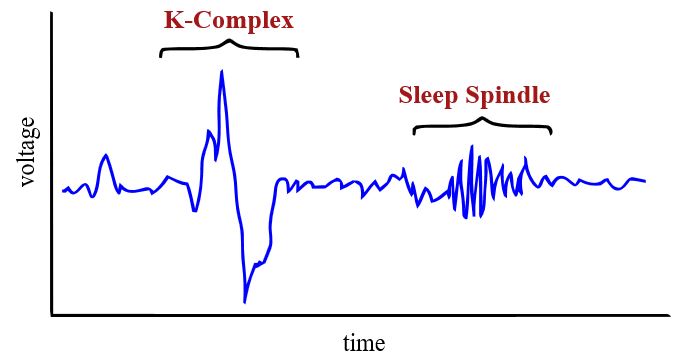
(Pic source: https://en.wikipedia.org/wiki/K-complex)
2. 判定规则
- Begin scoring stage N2 (in absense of criteria for N3) if one or both of the following occur during the first half of that epoch or the last half of the previous epoch:
A. One or more K complexes unassociated with arousals;
B. One or more trains of sleep spindles.
Note:
A. Continue to score stage N1 for epochs with arousal-associated K complexes but bi spontaneous K complexes or sleep spindles;
B. For the purposes of scoring N2 sleep, arousalsa are defined according to arousal rule V.1.
- The rule defines continuation of a period of stage N2 sleep: continue to score epochs with low amplitude, mixed frequency EEG activity without K complexes or sleep spindles as stage N2 if they are preceded by a) K complexes unassociated with arousals or b) sleep spindles.
- End stage N2 sleep when one of the following events occurs:
A. Transtition to stage W;
B. An arousal (change to stage N1 until a K complex unassociated with an arousal or a sleeo spindle occurs, see Figure 1);

C. A major body movement followed by slow eye movement and low amplitude mixed frequency EEG without non-arousal associated K complexes or sleep spindles (score the epoch following the major body movement as stage N1; score the spoch as stage N2 if there are no slow eye movements; the epoch containing the body movement is scored using criteria in Section 8; see Figrue 2);
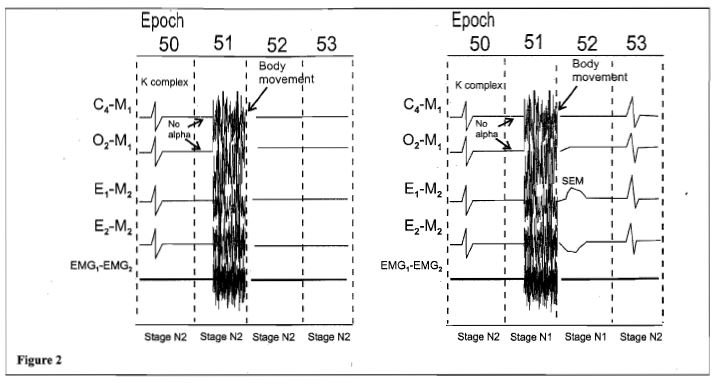
D. Transition to stage N3;
E. Transition to stage R.
- N2期睡眠起始判读规则:
如果判读帧前半帧或前一帧的后半帧存在与觉醒无关的K复合波、睡眠梭波,判读为N2期间开始(不符合N3期标准);
- N2期睡眠持续判读规则:
数帧不含K复合波或睡眠梭波的低波幅混合频率脑电活动,如果此前存在:① 非觉醒相关性K复合波或② 睡眠梭波,继续判读为N2期;
- N2期睡眠终止判读规则:
出现以下事件之一,判读为一段N2期结束:
A. 转为W期;
B. 一次觉醒转为N1,直到出现非觉醒相关性K复合波或睡眠梭波(见下图);
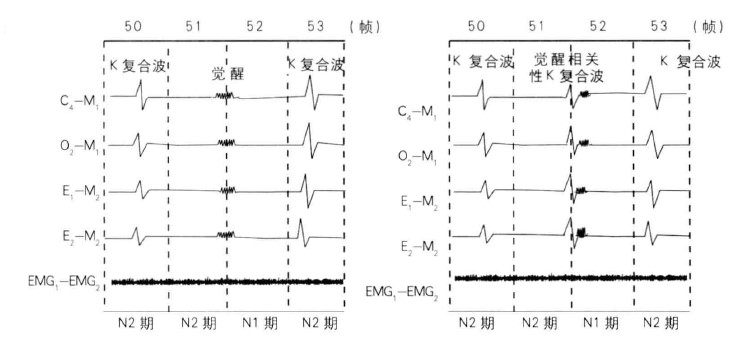
C. 一次大体动伴随缓慢眼动和低波幅混合频率脑电没有非觉醒相关性K复合波或睡眠梭波(大体动之后记录帧判读为N1期;如果没有缓慢眼动判读为N2期;含大体动记录帧判读规则见大体动部分)(见下图);

- 转为N3期;
- 转为R期。
3. 注意
- 眼电图通常在N2阶段不表现任何眼部活动,但是慢眼动也许会在某些被试中存在;
- 在N2阶段,下巴肌电图振幅多变,但通常比W阶段低,并可能低至和R阶段相仿。
♥ Stage 3
1. 定义
慢波活动:频率在0.5-2Hz之间,峰对峰振幅大于75微伏,在头部前侧区域测量得到的波形。
2. 判定规则
一个时段(epoch)内大于等于20%的时间由慢波活动组成,与年龄无关。
当慢波活动占一帧的20%以上时判读为N3,不用考虑年龄因素。
3. 注意
- 睡眠纺锤波可能持续到N3阶段;
- 眼动不常见于N3阶段;
- 在N3阶段,下巴肌电图振幅多变,通常低于N2阶段,有时会低至与R阶段相*水*。
♥ Stage R
1.定义
- 快速眼动(rapid eye movement,REM):成对的、不规律的、尖峰眼动,起始偏差持续小于500毫秒;
- 低下巴肌电图(low chin EMG tone):下巴肌电活动基线低于其他任何睡眠阶段,通常是整个记录中的最低水*;
- 锯齿波(sawtooth waves):一系列锯齿状、或三角形,2-6Hz的波形,其最大幅值出现在头部中央区域(central head regions),并且常常(并不总是)在快速眼动爆发过后出现;
- 瞬时肌肉活动(transient muscle activity):肌电图活动短期不规则爆发,通常持续时间小于0.25秒,叠加在肌电图低值部分(superimposd on low EMG tone)。该活动可以在下巴或前胫骨肌电图偏差、脑电图和眼电图偏差中看到,后者表示受脑神经支配肌肉的活动(activity of cranial nerve innervated muscles)。该活动在快速延东起达到最大。
2. 判定规则
- Define a epoch as stage R sleep with all the following phenomena:
A. Low amplitude, mixed frequency EEG;
B. Low chin EMG tone;
C. Rapid eye movements.
- The rule defines the continuation of a period of stage R sleep:
Continue tou score stage R sleep, even in the absence of rapid eye movements, for epochs following one or more epochs of stage E as defined above, if the EEG continues to show low amplitude, mixed frequency activity without K complexes or sleep spindles and the chin EMG tone remains low (Figure 3).
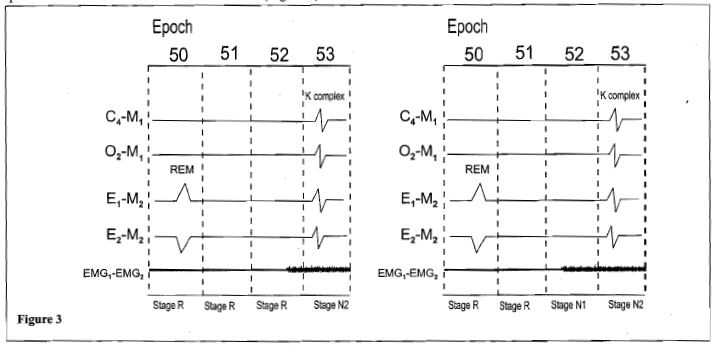
- The rule defined the end of a period of stage R sleep (when one or more of the following occur):
A. transition to stage W ro N3;
B. An increase in chin EMG tone above the level of stage R is seen and criteria for stage N1 are met (Figure 4);
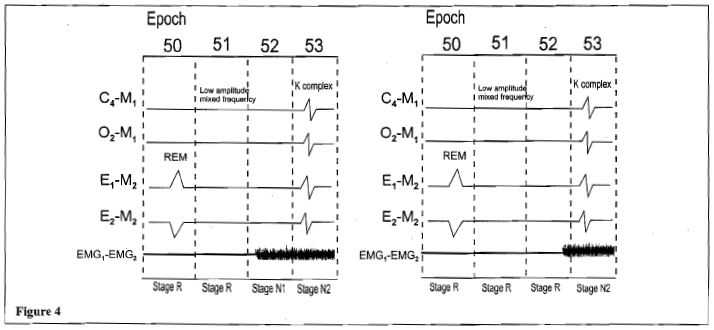
C. An arousal occurs followed by low amolitude, mixed frequency EEG and slow eye movements (scored as stage N1; if no slow eye movements and chin EMG tone remains low, continur to score as stage R; Figrue 5);

D. A major body movement followed by slow eye movements and low amplitude mixed frequency EEG withou non-arousal associated K comolexed or sleep spindles (score the epoch following theas stage N1; if no slow eye movements and the EMG tone remains low, continue to score as stage R; the epoch containing the body movement is scored using criteria in body section; Figrue 6);
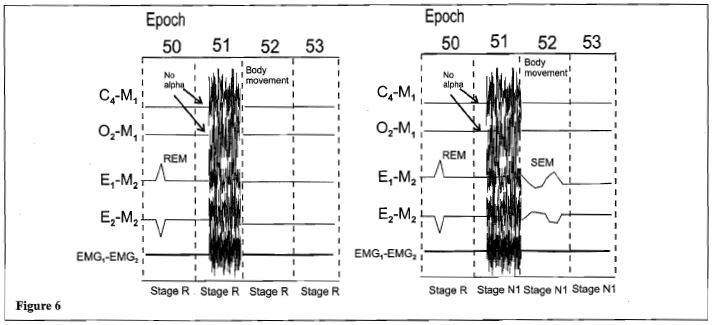
E. One or more non-arousal associated K comolexed or sleep spindles are present in the first half of the epoch in the absense of rapid eye movements, even if chin EMG tone remains low (scored as stage N2; Figure 7).
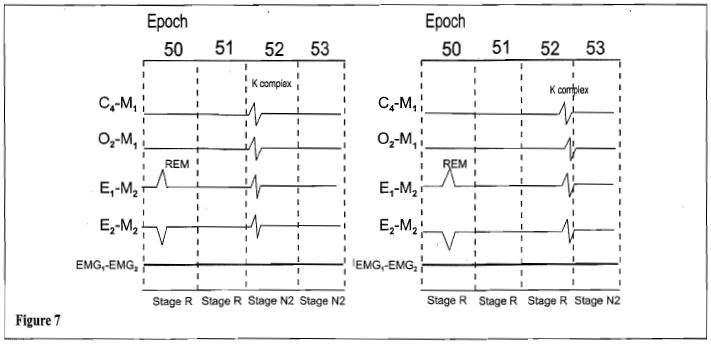
- Score epochs at the transition between stage N2 and stage R as follows:
A. In between epochs of definite stage N2 and definite stage R, score an epoch with a distinct drop in chin EMG in the first half of the epoch to the level seen in stage R as stage R if all of the following criteria are met, even in the absence of rapid eye movements (Figrue 8):
.. Absense of non-arousal associated K complexes;
.. Absense of sleep spindles.
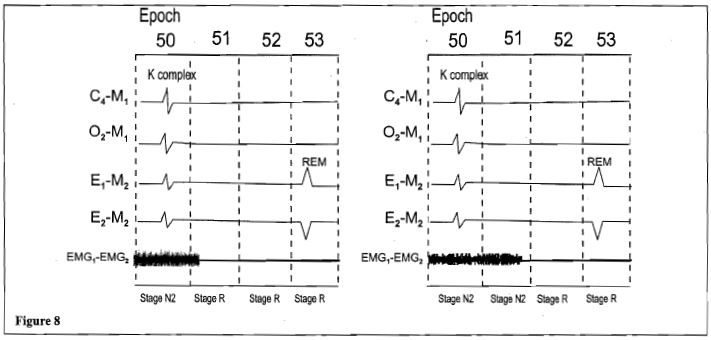
B. In between epochs of definite stage N2 and definite stage R, score an epoch with a distinct drop in chin EMG in the first half of the epoch to the level seen in stage R as stage N2 if all of the following criteria are met, even in the absence of rapid eye movements (Figrue 9A):
.. Presence of non-arousal associated K complexes or sleep spindles;
.. Absencce of rapid eye movements.
C. In between epochs of definite stage N2 with minimal chin EMG tone and defimite stage R without further drop in chin EMG tone, score epochs as stage R if all of the following are met, even in the absence of rapid eye movements (Figure 9B):
.. Absence of non-arousal associated K complexes;
.. Absence of sleep spindles.

- 记录帧呈现下列所有现象时判读为R期:
A. 低波幅混合频率脑电波;
B. 低张力颏EMG;
C. 快速眼动。
- R期睡眠持续判读规则
对于符合上述A项判读规则的一帧或多帧R期,其后连续数帧无快速眼动,此时如果EEG持续显示为低波幅混合频率活动,没有K复合波或睡眠梭形波,而且颏肌电张力仍低,判读为R期(如下图);

- R期睡眠终止判读规则
发生下列一项或一项以上时判读为R期终止:
A. 转为W期或N3期;
B. 颏肌电张力增加高于R期水*,并且符合N1期标准(如下图);

C. 觉醒后出现低波幅混合频率脑电和缓慢眼动(判读为N1期,如果无缓慢眼动并且颏肌电仍低则继续判读为R期)(如下图图);

D. 大体动后出现缓慢眼动和低波幅混合频率脑电,没有非觉醒相关性K复合波或睡眠梭形波(大体动随后帧判读为N1期,如果无缓慢眼动并且颏肌电仍低,持续判读为R期。含大体动帧判读标准见大体动部分)(如下图);
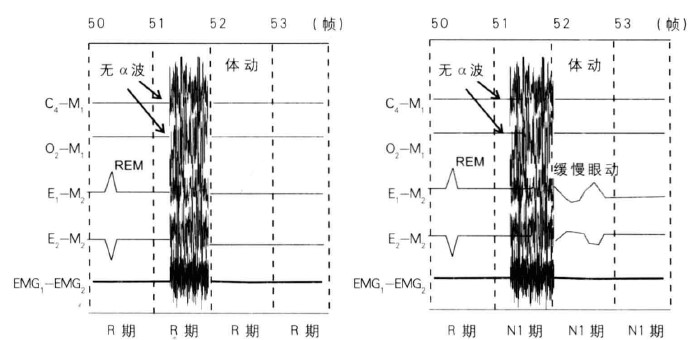
E. 一或多个非觉醒相关性K复合波或睡眠梭形波,呈现在没有快速眼动记录帧的前半部分,即使颏肌电张力仍低也判读为N2期(如下图)。
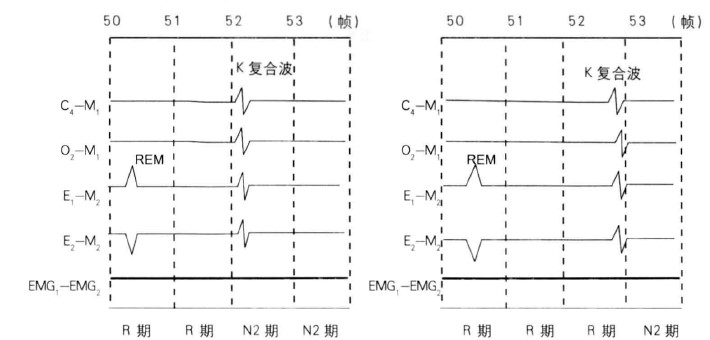
- N2期和R期间转化判读规则
A. N2期和R期间连续数帧记录中,若某一帧前半部颏肌电明显减低达到R期水*,并无非觉醒相关性K复合波及睡眠梭形波,即使无快速眼动,也判读此帧为R期(如下图);

B. N2期和R期间连续数帧记录中,若某一帧的前半部颏肌电明显减低达到R期水*,同时存在非觉醒相关性K复合波或睡眠梭形波并无快速眼动,判读为N2期(如下图);

C. N2期和R期间连续数帧记录中,如果颏肌电已在N2期下降到最低点并且在随后的记录帧中没有进一步下降,若无非觉醒相关性K复合波及睡眠梭形波,即使无快速眼动,也判读为R期(如下图)。

3. 注意
- R阶段低振幅,混合频率活动和N1阶段的很相似。在某些被试中,R阶段可以看到比N1阶段更多的α波。R阶段中的α波通常比清醒状态慢1-2Hz;
- 在判定阶段困难时,出现以下两种现象对判定为R阶段有很强支持作用:
A. 锯齿波;
B. 瞬时肌肉活动(R阶段中虽然会出现锯齿波和瞬时肌肉活动,但他们并不是判定R阶段的必要条件)。
- 有时,尤其是在夜间的第一个REM睡眠时期,K复合波或睡眠纺锤波可能在其中零散出现,而该时段可能并不是R阶段(K complexes or sleep spindles may be interspersed among epochs of what otherwise appears to be stage R sleep)。以上规则表明,出现快速眼动的时段,即使有K复合波或纺锤波出现,也应当判定为R阶段。然而, 如果快速眼动不出现,之后出现K复合波或纺锤波的时段应当被判定为N2阶段;及时下巴肌电图值较低(chin muscle tone remains low)。
♥ 大体动(Major body movements)
1. 定义
活动及肌肉伪迹(muscle artifact)导致EEG信号在一个时段内超过半数时间模糊不清,无法判定睡眠阶段。
身体运动和肌电干扰占据记录帧的50%以上,使该帧难以判读睡眠分期。
2. 判定规则
- If α rhythm si present for part of the epoch (even <15 seconds duration), score as stage W;
- If no α rhythm is discernable, but an epoch scorable as stage W either precedes or follows the epoch with a major body movement, score as stage W;
- Otherwise, score the epoch as the same stage as the epoch that follows it.
- 如果此记录帧部分含有α节律,判读为W期。
- 如果不存在可辨的α节律,但大体动帧之前或随后记录帧可判读为W期,则该帧也判读为W期。
- 其他情况下,此帧睡眠分期判读与其随后一帧相同。
♥ 觉醒(Arousal)
1. 判定规则
在N1、N2、N3或R阶段,如果EEG频率(包括α、θ或/及其他超过16Hz但并不是纺锤波的频率)发生突变,该突变持续至少3秒且在该突变之前有超过10秒的稳定睡眠,则判定为觉醒(arousal)。
2. 注意
- 唤醒的判定应该综合枕叶(occipital)和中央偏差;
- 唤醒的判定方法可以利用记录中的额外信息进行改善,例如呼吸以及/或额外的EEG通道。然而,唤醒的判定不能单独基于这些额外信息,这些信息也不能改变唤醒判定规则。
♥ 呼吸暂停
- 事件持续时间判读规则:
A. 判读呼吸暂停或低通气,测量事件持续时间,是从第一个波幅明显下降呼吸曲线的最低点到波幅接*基线呼吸的第一个呼吸曲线始点止这一段时间(水*大括号);
B. 基线呼吸暂停确定困难,也可根据呼吸幅度明显稳定增加,或在已经出现血氧饱和度减低的基础上事件相关的血氧饱和度增加至少2%,判读为事件终止。
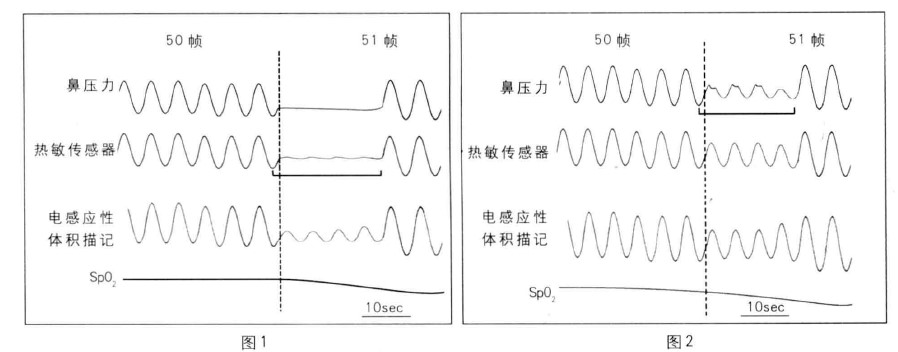
- 呼吸暂停判读
满足下列所有标准时判读为一次呼吸暂停(如下图):
A. 热敏传感器检测到呼吸气流曲线峰值下降≥90%基线值;
B. 事件持续时间至少10秒;
C. 至少90%事件持续期间内,呼吸气流波幅减低符合呼吸暂停标准。

- 低通气规则
A. 满足下列全部标准判读为一次低通气(如下图):
.. 鼻压力信号幅度(或替代低通气传感器信号幅度)下降≥30%基线值;
.. 一次下降持续时间至少10秒;
.. 血氧饱和度较事件前基线值下降≥4%;
.. 至少90%事件持续期间内,呼吸波幅减低必须符合低通气标准。
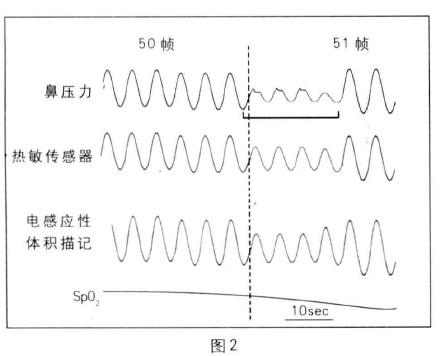
B. 满足下列全部标准判读为一次低通气:
.. 鼻压力信号下降≥50%基线值;
.. 一次下降持续时间至少10秒;
.. 血氧饱和度较基线值下降≥3%,或事件与微觉醒有关;
.. 至少90%事件持续期间内,呼吸波幅下降必须符合低通气标准。